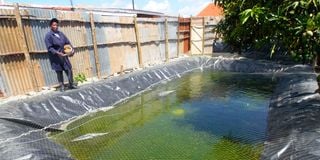Here is how to successfully hatch catfish and tilapia fries

Sabina Njoki at one of the ponds in Karungu Fish Farm which produces about 10,000 tilapia and catfish fingerlings in three months.
What you need to know:
- As more farmers embrace fish farming, getting quality fingerlings has become a challenge.
- Having a hatchery is one way to solve this problem, but farmers need to know how to do this right.
In Thika’s Landless area, on the Garissa road and just past the military barracks, is Karungu Fish Farm.
The farm, which is a breeder and a grower of tilapia and catfish, has 13 ponds and produces at least 10,000 fingerlings every three months.
Space is used to the maximum. Apart from fish, the plot has mango, pawpaw, mulberry, orange, pomegranate and avocado trees. It also produces onions, vegetables, cassava, sweet potatoes, parsley and herbs.
The farm gets water from an all-season spring.
“We realised the spring never dried up. We at first grew vegetables before being introduced to fish,” Margaret Nderi, the host farmer says.
Says Monica Nyangai, one of the experts at Karungu farm: “The hatchery ensures a consistent supply of high quality fingerlings. In this way, we are able to control the genetic quality of our stock to have fish that are adapted to this environment and resistant to diseases.”
Nyangai a bachelor’s degree in Applied Aquatic Science.
Mature male and females are selected for hatching. The female brooders are injected with a hormone and left for at least 12 hours before the eggs are stripped off.
Fertilisation is manual, with sperm added to the eggs by hand. The fertilised eggs are incubated at controlled temperatures and humidity. The eggs are on a net in the incubator.
Hatching is confirmed when they fall from the net to the bottom of the incubator. The bad eggs tend to turn white and remain on the net.
The fingerlings are nurtured in a greenhouse until they reach a suitable size for transfer to ponds.
Karungu fish experts say some factors are responsible for the success of a hatchery. These include good parenting stock, proper stripping and fertilisation, proper calculation and administration of the hormone, good water as well as feeding and disease management.
To ensure successful hatching, the recommend that a farmer stops feeding the fish for two days before selecting females for spawning.
One of the best indicators for a spawning stock is a soft, full abdomen. It means the fish have large well-developed egg sacs.

Sabina Njoki, an employee of Karungu Fish Farm, feeds the fish.
“If a fish has been recently fed, one may not tell whether the fullness is due to feed or it’s the egg sacs,” Nyangai says.
It is important to minimise stress in fish during selection.
“Handle the fish quickly but carefully. Rough handling could result in damage to the ovaries,” Sabina Njoki, a worker at the farm, says.
A good sign of proper timing is finding that the fish has golden brown or green eggs with few clumps or blood clots.
One with eggs that do not flow well or has a lot of eggs is usually an indication that ovulation was just starting or was incomplete.
It is important to determine accurately when the female has ovulated. If one attempts to strip the fish before ovulation, the eggs yield and quality will be poor.
Quality can also be compromised if one waits for too long after ovulation.
“Preventing diseases in a hatchery is important. Ensure the unfertilised and dead eggs are removed as they are a primary target for disease-causing pathogens,” Nyangai says.
After hatching, farmers should maintain the correct feeding regime as this determines the rate of growth of the fries to table-size.
Catfish fries are given Gemma feed for the first two weeks. One can switch to pellets as the fries increase in size.
The fish at Karungu Farm are also feed on azolla and fresh water shrimp.
The team at Karungu advises farmers to be cautious when sourcing fingerlings. Some “farmers” go to the extent of selling tadpoles.
“Buying fingerlings from certified and licensed farms ensures that farmers get good quality, healthy stock that will result in profits,” Nyangai says.
Karungu also educates farmers and the community on the benefits of fish rearing, including promoting food security and boosting income. The farm plans to process its fish and establish a restaurant.





